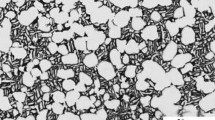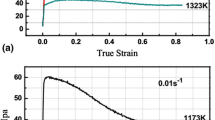Abstract
To better understand the fracture behavior of TA15 titanium alloy during hot forming, three groups of experiments were conducted to investigate the influence of deformation temperature, strain rate, initial microstructure, and stress triaxiality on the fracture behavior of TA15 titanium alloy. The microstructure and fracture surface of the alloy were observed by scanning electronic microscopy to analyze the potential fracture mechanisms under the experimental deformation conditions. The experimental results indicate that the fracture strain increases with increasing deformation temperature, decreasing strain rate, and decreasing stress triaxiality. Fracture is mainly caused by the nucleation, growth, and coalescence of microvoids because of the breakdown of compatibility requirements at the α/β interface. In the equiaxed microstructure, the fracture strain decreases with decreasing volume fraction of the primary α-phase (αp) and increasing α/β-interface length. In the bimodal microstructure, the fracture strain is mainly affected by α-lamella width.
Similar content being viewed by others
References
Y. Wang, S.Q. Zhang, X.J. Tian, and H.M. Wang, High-cycle fatigue crack initiation and propagation in laser melting deposited TC18 titanium alloy, Int. J. Miner. Metall. Mater., 20(2013), No. 7, p. 665.
J. Li, L. Zhou, and Z.C. Li, Microstructures and mechanical properties of a new titanium alloy for surgical implant application, Int. J. Miner. Metall. Mater., 17(2010), No. 2, p. 185.
D. Banerjee and J.C. Williams, Perspectives on titanium science and technology, Acta Mater., 61(2013), No. 3, p. 844.
Z.C. Sun, X.Q. Wang, J. Zhang, and H. Yang, Prediction and control of equiaxed a in near-β forging of TA15 Ti-alloy based on BP neural network: for purpose of tri-modal microstructure, Mater. Sci. Eng. A, 591(2014), p. 18.
D. He, J.C. Zhu, Z.H. Lai, Y. Liu, X.W. Yang, and Z.S. Nong, Residual elastic stress–strain field and geometrically necessary dislocation density distribution around nano-indentation in TA15 titanium alloy, Trans. Nonferrous Met. Soc. China, 23(2013), No. 1, p. 7.
H. Yang, X.G. Fan, Z.C. Sun, L.G. Guo, and M. Zhan, Recent developments in plastic forming technology of titanium alloys, Sci. China Technol. Sci., 54(2011), No. 2, p. 490.
J. Kumar, B. Srivathsa, and V. Kumar, Stress triaxiality effect on fracture behavior of IMI-834 titanium alloy: A micromechanics approach, Mater. Des., 30(2009), No. 4, p. 1118.
L. Driemeier, M. Brünig, G. Micheli, and M. Alves, Experiments on stress-triaxiality dependence of material behavior of aluminum alloys, Mech. Mater., 42(2010), No. 2, p. 207.
N. Allahverdizadeh, A. Gilioli, A. Manes, and M. Giglio, An experimental and numerical study for the damage characterization of a Ti–6AL–4V titanium alloy, Int. J. Mech. Sci., 93(2015), p. 32.
P.D. Nicolaou, R.L. Goetz, and S.L. Semiatin, Influence of stress state on cavitation during hot working of Ti–6Al–4V, Metall. Mater. Trans. A, 35(2004), No. 2, p. 655.
P.D. Nicolaou, R.L. Goetz, J.D. Miller, and S.L. Semiatin, The effect of stress state on cavity initiation during hot working of Ti–6Al–4V, Metall. Mater. Trans. A, 34(2003), p. 2397.
P.D. Nicolaou, J.D. Miller, and S.L. Semiatin, Cavitation during hot-torsion testing of Ti–6Al–4V, Metall. Mater. Trans. A, 36(2005), No. 12, p. 3461.
I. Cvijovic-Alagic, N. Gubeljak, M. Rakin, Z. Cvijovic, and K. Geric, Microstructural morphology effects on fracture resistance and crack tip strain distribution in Ti–6Al–4V alloy for orthopedic implants, Mater. Des., 53(2014), p. 870.
S.L. Semiatin, R.L. Goetz, V. Seetharaman, E.B. Shell, and A.K. Ghosh, Cavitation and failure during hot forging of Ti–6Al–4V, Metall. Mater. Trans. A, 30(1999), No. 5, p. 1411.
S.K. Li, B.Q. Xiong, S.X. Hui, W.J. Ye, and Y. Yu, Comparison of the fatigue and fracture of Ti–6Al–2Zr–1Mo–1V with lamellar and bimodal microstructures, Mater. Sci. Eng. A, 460-461(2007), p. 140.
B.R. Hu, J.Z. Liu, B. Chen, L.F. Wang, and X.R. Wu, Fatigue behavior and life prediction for argon-arc weld joints based on small crack methodology, [in] Proceedings of the 6th International Conference on Fracture and Strength of Solids, Bali Indonesia, 2006, p. 157.
D. Anderson, S. Winkler, A. Bardelcik, and M.J. Worswick, Influence of stress triaxiality and strain rate on the failure behavior of a dual-phase DP780 steel, Mater. Des., 60(2014), p. 198.
P.W. Bridgman, Studies in Large Plastic Flow and Fracture with Special Emphasis on the Effects of Hydrostatic Pressure, Harvard University Press, New York, 1952, p. 362.
X.J. Dong, S.Q. Lu, H.Z. Zheng, X. Li, and D.L. OuYang, Cavity nucleation during hot forging of Ti–6Al–2Zr–1Mo–1V alloy with colony alpha microstructure, Trans. Nonferrous Met. Soc. China, 20(2010), No. 12, p. 2259.
S.L. Semiatin, V. Seetharaman, A.K. Ghosh, E.B. Shell, M.P. Simon, and P.N. Fagin, Cavitation during hot tension testing of Ti–6Al–4V, Mater. Sci. Eng. A, 256(1998), No. 1-2, p. 92.
R. Kiran and K. Khandelwal, A triaxiality and Lode parameter dependent ductile fracture criterion, Eng. Fract. Mech., 128(2014), p. 121.
H. Li, M.W. Fu, J. Lu, and H. Yang, Ductile fracture: experiments and computations, Int. J. Plast., 27(2011), No. 2, p. 147.
A. Bacha, D. Daniel, and H. Klocker, Metal ductility at low stress triaxiality application to sheet trimming, J. Mater. Process. Technol., 203(2008), No. 1-3, p. 480.
Y.B. Bao and T. Wierzbicki, On fracture locus in the equivalent strain and stress triaxiality space, Int. J. Mech. Sci., 46(2004), No. 1, p. 81.
Author information
Authors and Affiliations
Corresponding author
Rights and permissions
About this article
Cite this article
Yang, L., Wang, By., Lin, Jg. et al. Ductile fracture behavior of TA15 titanium alloy at elevated temperatures. Int J Miner Metall Mater 22, 1082–1091 (2015). https://doi.org/10.1007/s12613-015-1171-2
Received:
Revised:
Accepted:
Published:
Issue Date:
DOI: https://doi.org/10.1007/s12613-015-1171-2




